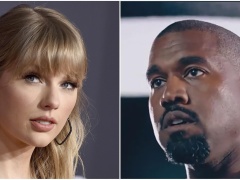
Writer-director Siân Heder makes it very clear she knew the double meaning of “CODA,” the title of her new Apple TV Plus film, an acronym for Child of Deaf Adults. It’s used to describe the movie’s star, Emilia Jones, who plays would-be singer Ruby, a character eking out a living with her father Frank (Troy Kotsur), mother Jackie (Marlee Matlin) and brother Leo (Daniel Durant) — all deaf actors — aboard a fishing boat in scenic Gloucester, Mass.
“When I learned about the use of the term within the deaf community, in the context of music, it resonated for a coming-of-age story,” explains Heder, whose previous film was the gritty 2016 Sundance hit, “Tallulah,” with Allison Janney and Elliot Page. “To me, ‘CODA’ also represents the end of childhood, saying goodbye to the identity which exists within your family, bringing that part of your life to a close.”
From the moment we first meet Emilia Jones’ Ruby, singing along to Etta James’ “Something’s Got a Hold on Me,” spearing and stacking fish while her parents and brother work nearby unaware of her honey-soaked vocals, the conflict reveals itself: here was a clearly nascent talent and a need to be the voice for her family.
The film’s soundtrack, on Republic Records, features a combination of a subtle, but swelling emotional orchestral score by composer Marius de Vries, who earned his film music bonafides working under Baz Luhrmann on both “Romeo & Juliet” and “Moulin Rouge,” as well as songs heard in the film, ranging from The Clash’s “I Fought the Law” to Marvin Gaye and Tammi Terrell’s “You’re All I Need to Get By,” the latter a show-stopper Ruby learns to conquer with her duet partner and budding love interest Miles (“Sing Street” star Ferdia Walsh-Peelo). Other highlights include Jones’ version of Joni Mitchell’s “Both Sides Now” (performed during an audition for Berklee School of Music with American Sign Language) and a closing, end-credit original, “Beyond the Shore,” written by de Vries, Heder and album co-producer Nicholai Baxter, a surefire best original song contender.
“I’ve always been drawn to soundtrack albums that take the listeners on the journey of reliving the movie, even if it’s from a completely different perspective,” says Baxter. “Especially for a film like this, it’s rewarding to be able to experience that again, in audio form.”
The idiosyncratic song choices — at one point, Ruby and Miles bond over a love of New Hampshire cult group the Shaggs’ “My Pal Foot Foot” — were a product of discussions involving superstar music supervisor Alexandra Patsavas, who now heads music at Netflix. Among the songs covered by Ruby and her school choir, representing the enlightened exuberance and encouragement of school choir conductor Mr. V aka Bernardo Villalobos (Mexican star Eugenio Derbez): David Bowie’s “Starman” and Kiki Dee’s “I’ve Got the Music in Me.”
“It was important to establish that Ruby had broad musical tastes, some of which reached back before she was born, meaning she knew her history,” says de Vries. “What bound all this eclectic music together was having to craft much of it for a performance by a high school choir.”
“I wanted to show that Ruby was a record bin hunter,” says Heder about the Shaggs reference, giving a nod to Patsavas. “This is an interesting kid who digs deep to find music. That’s why I have Miles wearing a King Crimson T-shirt when they first meet. The two end up bonding over their love of obscure artists.”
Perhaps the highlight of the film is when Ruby auditions for the prestigious Berklee School of Music singing “Both Sides Now,” suddenly beginning to sign the song halfway through when she notices her parents and brother sitting in the auditorium balcony.
“’Both Sides Now’ was the perfect song choice for Ruby,” acknowledges Jones. “Joni Mitchell said she was meditating on fantasy and reality when she wrote it – a combination of childlike optimism and adult reality. She said it was the work of ‘childhood’s end,’ which was perfect for Ruby because that was where she was in her life. It was the moment where she had to separate from the people she loves and figure out who she is outside of her childhood identity.”
“Nic and Alex actually pushed me towards that song,” says Heder. “I was concerned because it’s so iconic. But in terms of ‘CODA,’ from both a hearing and deaf perspective, it makes sense because Ruby is seeing the world through these two different eyes. It felt like the perfect song to represent that ‘CODA’ experience, how you balance things from these diverse perspectives. It is the ideal resolution for the film.”
Like the Oscar-winning “Sound of metal,” “CODA” uses the bond between ASL (American Sign Language) and music to make a universal point. That is why de Vries’ orchestral score is more prominent in the second half of the film, reflecting Ruby’s expanding world, the swelling symphony putting melody to her yearning, aspirations and dreams, the potential beyond her narrow, circumscribed community.
“There is a strong connection between deaf culture and music,” says Heder. “ASL, as a language, is closer to music than spoken word — it is expressive, melodic, rhythmic, visual and three-dimensional in the same way music is. You use your whole body, and experience what you say as you’re saying it. You live in those emotions being described as you communicate.” She adds, “The ASL scenes, even though not accompanied by music, are far from silent. They are full of incredible, intimate sounds of breath, vocalization, the way fingers hit against clothes or hands slap together in anger. It would have been very easy for the music to overwhelm what was happening on screen. We intentionally wanted to force the audience into an experience of that silence, getting them comfortable with it. once the audience is invested in these characters, and emotionally involved, then it felt OK to bring score music in.”
Before filming began, Jones hadn’t had a singing lesson in her life. The improvement she makes over the course of the movie, from running out on an audition, to belting out “Both Sides Now” represents her own real growth as an artist.
For Jones, who had to both sign and sing, it took incremental steps to get to the finish line. “Doing both at the same time was the hardest,” she says. “Because even if you sing well and portray the right emotion, if you mess up the sign language, the take can’t be used. It was like multi-tasking under pressure.”
Indeed, most of the musical performances were filmed and recorded live, mistakes and all.
“While singing ‘Both Sides Now,’ I remember getting so emotional when I looked up and saw Marlee, Troy and Daniel there,” says Jones. “So much so, I completely messed up the ending, but Siân chose to use that take, I guess because it was so raw and emotional.”
The end credit original, “Beyond the Shore,” captures how Emilia has grown as a singer during the film.
“That song was probably more about running out of budget and being stuck in the pandemic during post and unable to do anything,” adds Heder. “We really wanted to create something emotional and beautiful. We thought, wouldn’t it be great to write a song for Emilia to record as her first release? We were excited about the possibilities of who Emilia can be in a singer.”
“That was the only song I didn’t sing live on set,” recalls Jones. “I closed my eyes in the studio and remembered the bond between Ruby and her father. When I sing the line, ‘And in your eyes, I could see there was more to me’ — it was a moment of connection and understanding between a father and daughter than it was the music.”
During the climactic concert scene, Heder makes a choice to go silent for almost 30 seconds, as Ruby’s parents gaze into the eyes of the audience to see how delighted they are with the performance. It is a moment of quiet that expresses the joy of music without a sound.
“I see the film as a conversation between these two languages — ASL and music — which echo each other in very beautiful ways,” adds Heder. “The idea that those two things are separate worlds is a misconception and it’s important to understand the overlap between those two experiences.”






